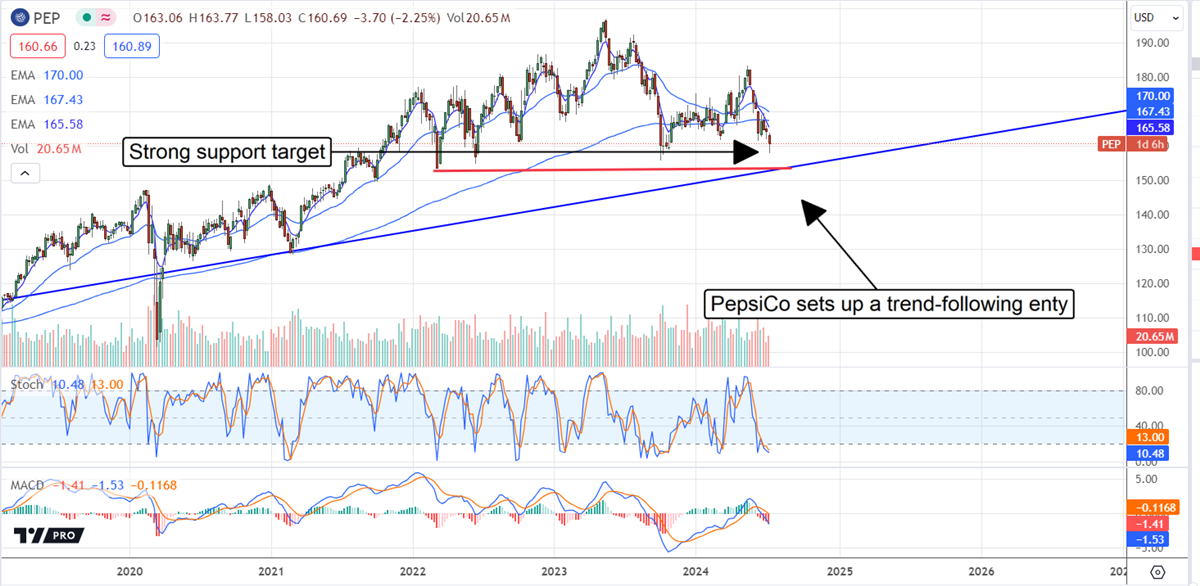
PepsiCo (NASDAQ: PEP) shares have struggled with traction for the last two years as inflation, pricing pressure, consumer pushback, and economic headwinds impact results, but those days will soon end. The latest CPI report shows inflation cooling faster than expected and has the FOMC on track to make at least one interest rate cut this year. The takeaway is that PepsiCo continues to build leverage for investors with operational improvement and territorial expansion that will drive accelerated results over the coming years because the cost of money will fall, impacting activity across the spectrum and driving demand for PepsiCo beverages, snacks, and breakfast items.
PepsiCo Falls on Cautious Guidance, Sets Up Trend Following Entry
PepsiCo’s Q2 results are mixed and give reason for caution but also reveal the strength of its diversified model and international expansion efforts. The $22.5 billion net revenue is weaker than expected but up 0.8% compared to last year and only 44 bps below the consensus reported by MarketBeat.
The revenue weakness is centered in North America and Quaker Oats, which experienced recalls during the period. It fell 18% segmentally, while results in all other segments were milder. Frito Lay NA and APAC/NZ contracted by slim 0.5% and 2% margins while the core PepsiCo NA, Latin America, Europe, and other emerging markets grew. Growth was most robust in Latin America, where economic expansion and the growing middle class drive demand. It rose by 7% and can be expected to lead over the next few quarters. Emerging markets in Africa and South Asia will also likely perform well over the coming years.
The margin is good despite the headwinds. The company’s efforts to control costs and improve efficiency are paying off, allowing the company to lean less heavily on pricing increases than others in the category. The net result is improved gross and operating margins on a GAAP and adjusted basis, with the adjusted operating margin up 150 basis points. The bottom line is that GAAP earnings grew by 13% and adjusted by 10% to outpace the top-line advance by more than 1000 basis points, and the leverage is expected to stick.
The guidance caused the stock price to fall, but it is better than it appears at first glance. Due to the Q2 trends, the company tempered its outlook for revenue growth marginally from at least 4% to a solid 4% while maintaining the EPS outlook. EPS is expected to grow at a high single-digit pace and sustain robust cash flow.
PepsiCo Builds Value for Investors With Cash Flow and Capital Returns
PepsiCo had a cash-flow-negative quarter, but the timing of payments, debt reduction, and improved shareholder equity offset that detail. Equity is up 5% after the capital returns, including the dividend and share repurchases. PepsiCo isn’t an aggressive repurchaser but reduced its count by 0.36% average for the quarter, providing an updraft for the stock price.
Regarding the balance sheet, the debt levels are low at less than 2x equity and 6x cash, so capital returns are safe. Investors can expect this Dividend Aristocrat to continue paying its S&P 500-leading $5.42 annualized payout indefinitely and for distribution increases to continue for the foreseeable future.
PepsiCo Falls Into Deep-Value Territory: Trend-Following Signal to Follow
PepsiCo’s share price fell more than 2% on the Q2 release, but the takeaway from the price action is bullish. The market is buying the dip and setting up a trend-following signal in this consumer staple that could lead to a multi-year rally. The stock could climb $10 to the $170 level soon because that is the low end of the analysts' range, and higher prices are likely. Assuming the analysts maintain their buy rating and do not lower the range, this stock could rebound to $190 to $200 within the next quarter or two.







